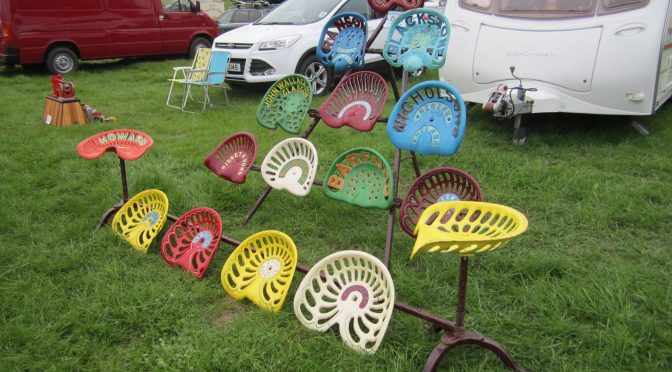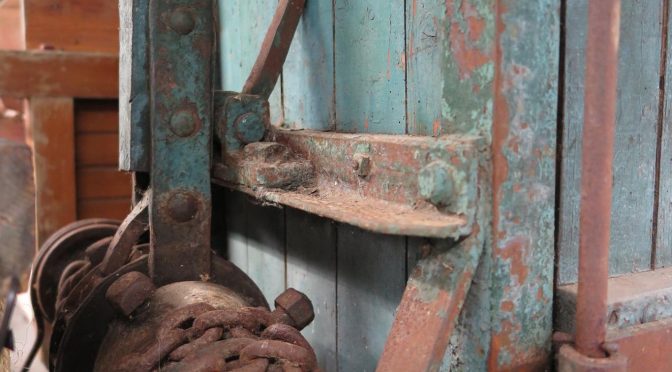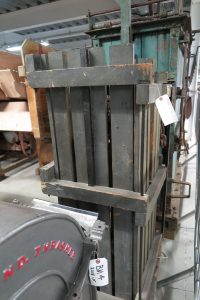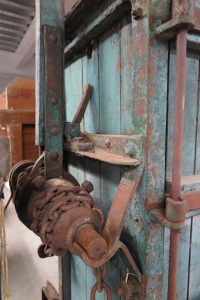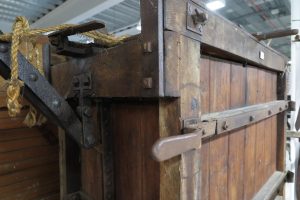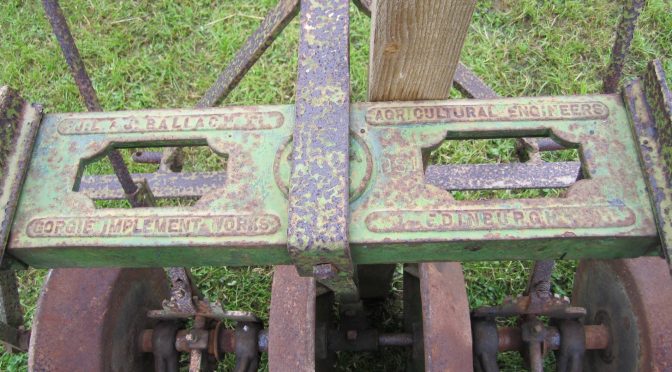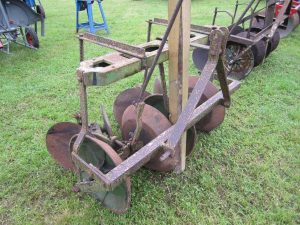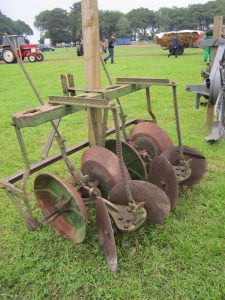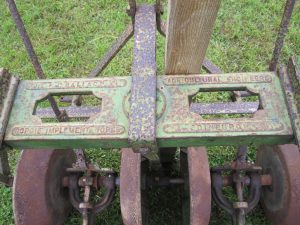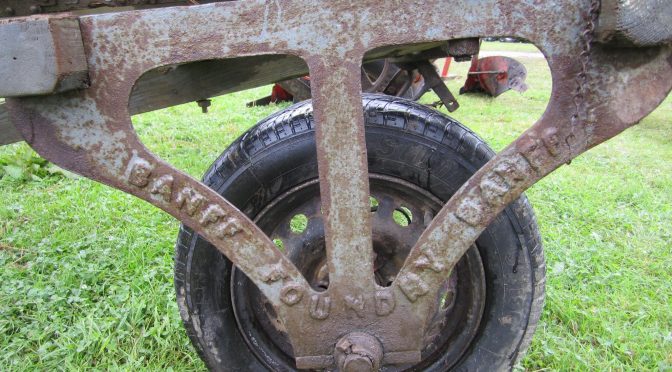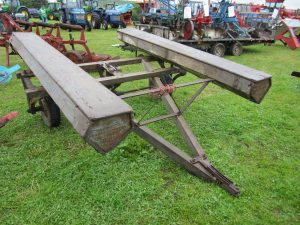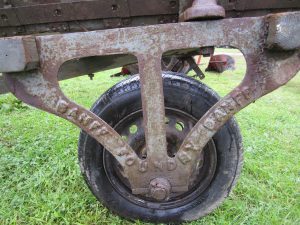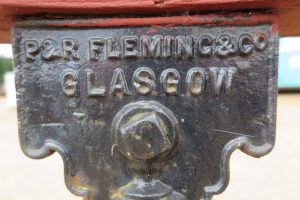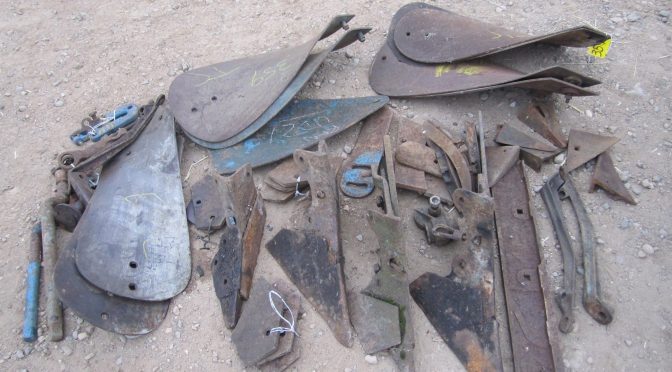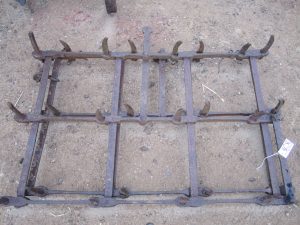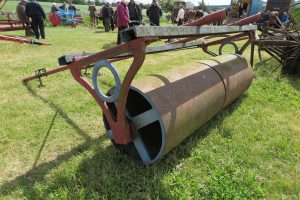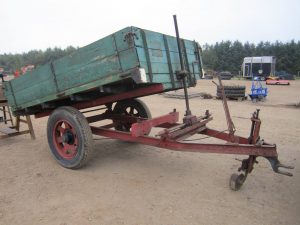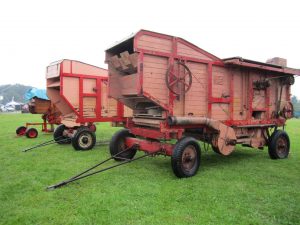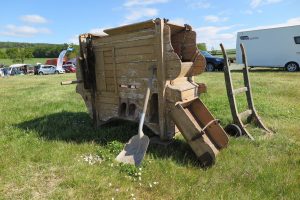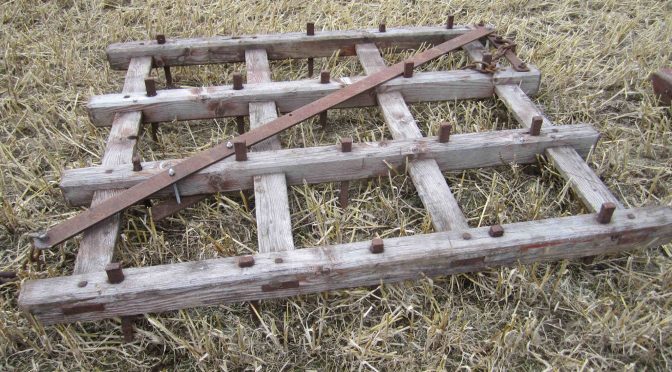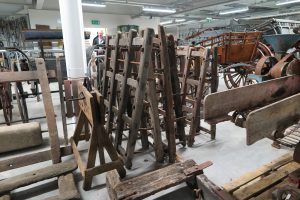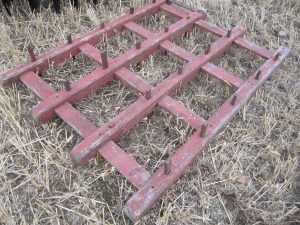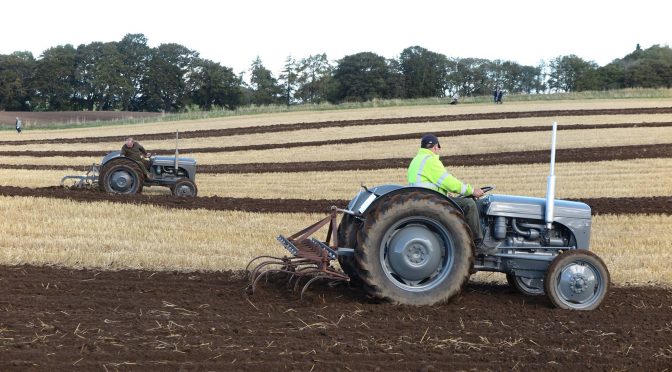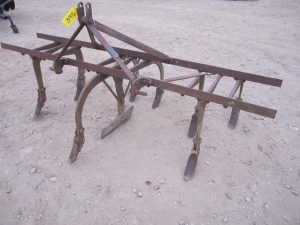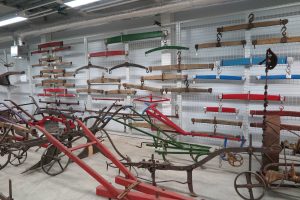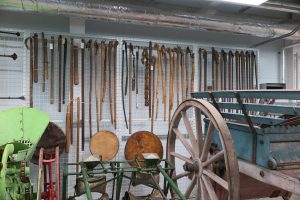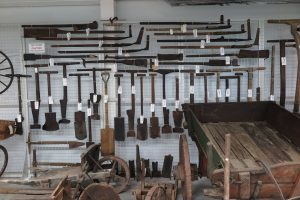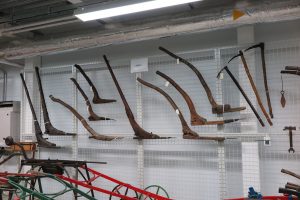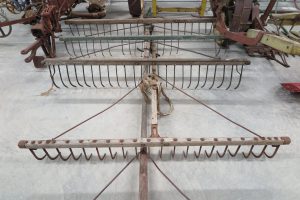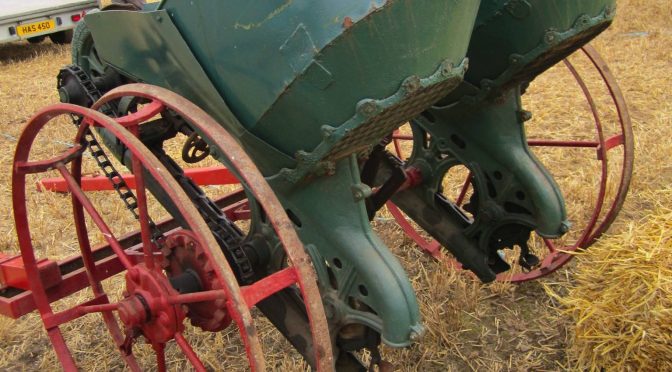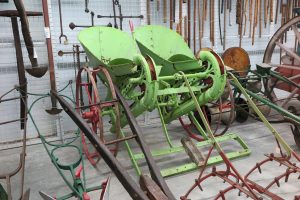The Board of Agriculture and Internal Improvement undertook an important survey of agriculture and rural improvement in Britain from 1793 to 1817. Each survey generally focused on a county or a small number of counties.
The accounts contained detailed accounts of the implements and machines used in each county, together with the changes that were being made to them.
The account for Perthshire provides insights into the character and state of implements used in that county. The short account is worth quoting at length:
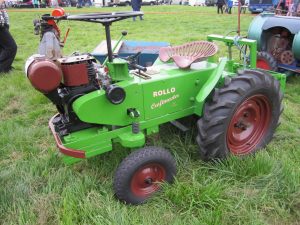 “All the implements of husbandry are constructed according to better models and made of better materials, than formerly. So late as 20 years ago, no plough was to be seen, but on a gentleman’s farm in the low lands of this country, except that which is now called the old Scotch plough, drawn by four oxen and two horses, or by four horses and two oxen. In the Highlands the same kind of plough was universally used, drawn by four horses all yoked abreast. Instead of carts with wheels moveable upon the axlel that clumsy machine, in which the wheels were fixed to the axle, described by the President of the Board and still to be met with in the northern counties, was very common in all the low lands of Perthshire. The wheels had no speaks or naves. They were composed of three sections of solid plank, fixed together and rounded like the bottom of a large cask; and the axle was fixed in the centre, going through the middle section. The shafts had two pins that embraced the axle and made these awkward wheels tumble along; from which circumstance they were named tumblers. A
“All the implements of husbandry are constructed according to better models and made of better materials, than formerly. So late as 20 years ago, no plough was to be seen, but on a gentleman’s farm in the low lands of this country, except that which is now called the old Scotch plough, drawn by four oxen and two horses, or by four horses and two oxen. In the Highlands the same kind of plough was universally used, drawn by four horses all yoked abreast. Instead of carts with wheels moveable upon the axlel that clumsy machine, in which the wheels were fixed to the axle, described by the President of the Board and still to be met with in the northern counties, was very common in all the low lands of Perthshire. The wheels had no speaks or naves. They were composed of three sections of solid plank, fixed together and rounded like the bottom of a large cask; and the axle was fixed in the centre, going through the middle section. The shafts had two pins that embraced the axle and made these awkward wheels tumble along; from which circumstance they were named tumblers. A 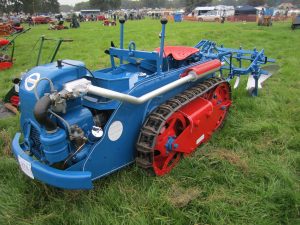 timber mallet wrought by the hand was all they had for a roller to break the clods in the stiff land of the cases. Manners were very rare, and threshing machines not known. In the Highlands, the people performed distant carriages of bulky commodities with hurdles, fixed on each side of the horse, by means of a hooked car-saddle, still remembered by the name of currants. Less bulky commodities were carried in hampers or baskets, made of young haze, with a square mouth, and fixed on the horse’s back with the same car-saddle. Near carriages, particularly the ingathering of their hay and corns, were executed with a sledge, which consisted of two shafts reaching from the collar on the horse’s neck to the ground, with cross bars near the horse’s hind-feet, for a bottom, and at least seven erect bars behind, for keeping on the load. This sledge succeeded the hurdle and evidently required some rpoad, whereas the hurdle could be used wherever it was possible for a horse to watch. The name which this sledge has in the language of the Highlands shows that it was the carries of the gauls in Ceasar’s time; and the English name car is borrowed evidently from the Latin. Upon this sledge or car the farmers in the Highlands carried out the dung in large baskets, diverging towards the mouth in the shape of an equilateral triangle, one side of the basket lying on the bottom or
timber mallet wrought by the hand was all they had for a roller to break the clods in the stiff land of the cases. Manners were very rare, and threshing machines not known. In the Highlands, the people performed distant carriages of bulky commodities with hurdles, fixed on each side of the horse, by means of a hooked car-saddle, still remembered by the name of currants. Less bulky commodities were carried in hampers or baskets, made of young haze, with a square mouth, and fixed on the horse’s back with the same car-saddle. Near carriages, particularly the ingathering of their hay and corns, were executed with a sledge, which consisted of two shafts reaching from the collar on the horse’s neck to the ground, with cross bars near the horse’s hind-feet, for a bottom, and at least seven erect bars behind, for keeping on the load. This sledge succeeded the hurdle and evidently required some rpoad, whereas the hurdle could be used wherever it was possible for a horse to watch. The name which this sledge has in the language of the Highlands shows that it was the carries of the gauls in Ceasar’s time; and the English name car is borrowed evidently from the Latin. Upon this sledge or car the farmers in the Highlands carried out the dung in large baskets, diverging towards the mouth in the shape of an equilateral triangle, one side of the basket lying on the bottom or 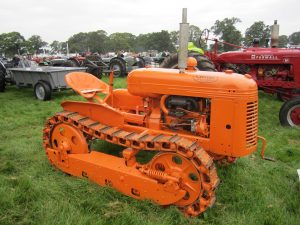 floor of the sledge; but where the road would not admit of the sledge, the dung was carried to the field in baskets with moveable bottoms, like a valve, fixed to the hooked car-sadle, which opened in the bottom by a pin and dropped the dung where it was necessary. On these sledges they carried home their peats in other baskets of a square form and of such capacity as to hold a horse’s load; but where the road was so steep that the car could not be used, they adopted small baskets of the same form, fixed on the horse’s sides to the hooked car-sadly. In many parts of the Highlands, these sledges are still employed for carrying grain and hay, as well as peats; especially where the roads are so rugged and uneven as to render the use of carts impracticable. however censurable this practice may appear to a stranger, yet in some situations it is unavoidable; and at first sight it would seem incredible, with what dispatch and safety the people perform their work, and also with fewer hands than carts or wagons
floor of the sledge; but where the road would not admit of the sledge, the dung was carried to the field in baskets with moveable bottoms, like a valve, fixed to the hooked car-sadle, which opened in the bottom by a pin and dropped the dung where it was necessary. On these sledges they carried home their peats in other baskets of a square form and of such capacity as to hold a horse’s load; but where the road was so steep that the car could not be used, they adopted small baskets of the same form, fixed on the horse’s sides to the hooked car-sadly. In many parts of the Highlands, these sledges are still employed for carrying grain and hay, as well as peats; especially where the roads are so rugged and uneven as to render the use of carts impracticable. however censurable this practice may appear to a stranger, yet in some situations it is unavoidable; and at first sight it would seem incredible, with what dispatch and safety the people perform their work, and also with fewer hands than carts or wagons  would require. Sledges are indeed going out, and ought to be so, where the cross-roads in a county or the by-roads in a farm are passable by carts. But notwithstanding every improvement which the roads have undergone; the principal lines of communication having deservedly claimed the first attention of the public; this has hitherto left the roads in other situations, in such a state, especially where the country is rocky or hilly, that carts would be overturned every moment. Distant carriages in every part of this county, where the journey is on the king’s highway, are universally performed by carts.
would require. Sledges are indeed going out, and ought to be so, where the cross-roads in a county or the by-roads in a farm are passable by carts. But notwithstanding every improvement which the roads have undergone; the principal lines of communication having deservedly claimed the first attention of the public; this has hitherto left the roads in other situations, in such a state, especially where the country is rocky or hilly, that carts would be overturned every moment. Distant carriages in every part of this county, where the journey is on the king’s highway, are universally performed by carts.
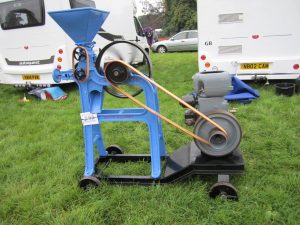 It is to be hoped, if the wagons used in the moor-lands of Yorkshire could be introduced with advantage into the Highlands of Scotland, as Mr Marshall says they can, that the Board will favour the county with a drawing of one, accompanied with directions how to use it.
It is to be hoped, if the wagons used in the moor-lands of Yorkshire could be introduced with advantage into the Highlands of Scotland, as Mr Marshall says they can, that the Board will favour the county with a drawing of one, accompanied with directions how to use it.
It was deemed unnecessary to give a long description or any drawing of these uncouth implements, as they are mostly exploded, and gradually give way to modern improvements. They were only used through necessity, arising from the peculiar circumstances of the country, and must disappear, when that necessity is removed.
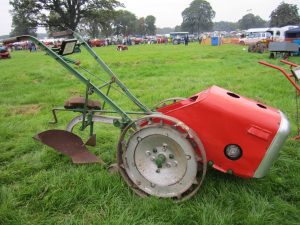 One improvement leads to another. No sooner were the roads attended to, than carts were introduced; and no sooner were lessons in husbandry learned by common farmers from the proprietors, of whom they held their possessions, or from reading and observing the practice of countries more highly cultivated than their own, than they were emulous to follow the examples set before them, both in the execution of their work and in the construction of the various implements they employed: and we begin to be astonished at this day, how the farmers, even about the middle of this century, could work with such homely utensils, in the way of their possession, or keep themselves alive by the modes of farming practised in the old school.
One improvement leads to another. No sooner were the roads attended to, than carts were introduced; and no sooner were lessons in husbandry learned by common farmers from the proprietors, of whom they held their possessions, or from reading and observing the practice of countries more highly cultivated than their own, than they were emulous to follow the examples set before them, both in the execution of their work and in the construction of the various implements they employed: and we begin to be astonished at this day, how the farmers, even about the middle of this century, could work with such homely utensils, in the way of their possession, or keep themselves alive by the modes of farming practised in the old school.
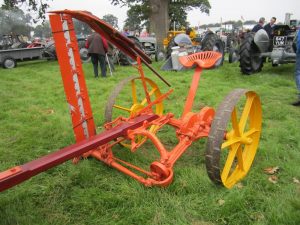 Every implement of farming, used almost over the whole county, is now formed after the most approved models known in Britain in the construction of which, such a quantity of iron is annually consumed, as would have been thought incredible by the grandfathers of the present farmers. In some sequestered corners, especially where the tenants are poor, the landlords oppressive or the soil difficult to be reclaimed, the dawn of improvement is only beginning to appear; but these forlorn spots bear no proportion to the happier districts of the country, where cultivation is cherished by the benignity of the landlord and the industry of the tenantry, and is ascending to its meridian altitude.
Every implement of farming, used almost over the whole county, is now formed after the most approved models known in Britain in the construction of which, such a quantity of iron is annually consumed, as would have been thought incredible by the grandfathers of the present farmers. In some sequestered corners, especially where the tenants are poor, the landlords oppressive or the soil difficult to be reclaimed, the dawn of improvement is only beginning to appear; but these forlorn spots bear no proportion to the happier districts of the country, where cultivation is cherished by the benignity of the landlord and the industry of the tenantry, and is ascending to its meridian altitude.
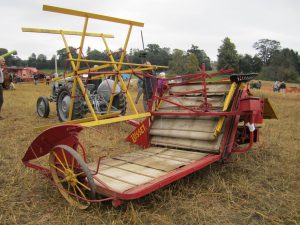 The plough, used by many of the most knowing farmers, is that with a chain and curved mould-board generally of cast iron. Some very intelligent farmers, about the east bridge of Earn, reject the chain, but strengthen the beam with two lateral bars of iron, from the muzzle back to the great stilt or handle of the plough.
The plough, used by many of the most knowing farmers, is that with a chain and curved mould-board generally of cast iron. Some very intelligent farmers, about the east bridge of Earn, reject the chain, but strengthen the beam with two lateral bars of iron, from the muzzle back to the great stilt or handle of the plough.
In Monteith some of the best farmers make use of an improved small Scotch plough, in preference to that with the cast iron mould board invented by Mr Small at Ford, both on account of its lightness, and because it does not throw the furrow of clay-land so much on its back. In stony land, the round share is most in use; in land, which is free of stones, the feathered share is preferred, on account of the neatness of its furrow; and indeed in tough or new land, no other share will cut the roots of grass and weeds, or turn over the surface, with the same ease or equal beauty.
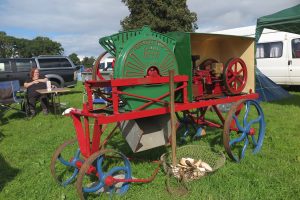 These four kinds of ploughs are drawn each by two horses; but in a great part of the country to which this account refers, the old Scotch plough, drawn by three or four horses, is still in use: and in some places the barbarous custom is not exploded, of yoking four horses a breast, and of driving them by a man going backward. This practice appears very awkward and very much poaches the ground; yet they contend in their own defence, that the horses yoked in this manner act with greater power than otherways; that the ground is in many places so full of large stones, as not to admit the long plough; that the driver, by having his eye at once on the horses and plough, can stop the draught more instantaneously and save the harness (gratis) better than in any other position; that they are under the necessity of keeping small horses, adapted to their pasture in the moors, and require more of them to execute the labour of a plough-gate of land. It is to be hoped,
These four kinds of ploughs are drawn each by two horses; but in a great part of the country to which this account refers, the old Scotch plough, drawn by three or four horses, is still in use: and in some places the barbarous custom is not exploded, of yoking four horses a breast, and of driving them by a man going backward. This practice appears very awkward and very much poaches the ground; yet they contend in their own defence, that the horses yoked in this manner act with greater power than otherways; that the ground is in many places so full of large stones, as not to admit the long plough; that the driver, by having his eye at once on the horses and plough, can stop the draught more instantaneously and save the harness (gratis) better than in any other position; that they are under the necessity of keeping small horses, adapted to their pasture in the moors, and require more of them to execute the labour of a plough-gate of land. It is to be hoped, 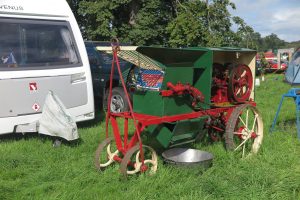 however, that by the increasing cultivation of sown grasses, their food for horses and all other cattle will be more abundant; that a breed of larger horses will be employed; that two-horse ploughs will be made use of, and all arguments in defence of horses yoked abreast become unnecessary. The saving in point of harness and horses, besides having only one man in place of two, is so great and so evident, in favour of two horse ploughs, that they are fast gaining ground, in every district of the county, and it is hoped will soon be universal.
however, that by the increasing cultivation of sown grasses, their food for horses and all other cattle will be more abundant; that a breed of larger horses will be employed; that two-horse ploughs will be made use of, and all arguments in defence of horses yoked abreast become unnecessary. The saving in point of harness and horses, besides having only one man in place of two, is so great and so evident, in favour of two horse ploughs, that they are fast gaining ground, in every district of the county, and it is hoped will soon be universal.
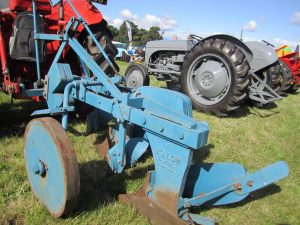 The harrows consist for the most part of fourbars (bulls) with iron teeth. Some are made large enough to be a draught for two horses, which are distinguished by the name of Breakers. The teeth of these are formed like small coulters, having square tops, which are put upward into the bars, contrary to the common method method of pushing the teeth downward. Into that part of the teeth which rises above the bar, there is, in each tooth, an oblong hole, into which a flit-nail is put, that keeps the teeth immoveable are prevents their being lost. This kind of harrow is extremely well calculated for breaking up the large clods of a fallow or any course land. The smaller harrows, with common teeth, are joined together by a coupling iron; and in some instances by a double coupling iron, introduced into Monteith and recommended by Lord Kaimes.
The harrows consist for the most part of fourbars (bulls) with iron teeth. Some are made large enough to be a draught for two horses, which are distinguished by the name of Breakers. The teeth of these are formed like small coulters, having square tops, which are put upward into the bars, contrary to the common method method of pushing the teeth downward. Into that part of the teeth which rises above the bar, there is, in each tooth, an oblong hole, into which a flit-nail is put, that keeps the teeth immoveable are prevents their being lost. This kind of harrow is extremely well calculated for breaking up the large clods of a fallow or any course land. The smaller harrows, with common teeth, are joined together by a coupling iron; and in some instances by a double coupling iron, introduced into Monteith and recommended by Lord Kaimes.
In some places on the Carse of Cowrie and Storming the harrows have what are called riders. The far-bar of the near harrow, (when more than one are yoked together) has three timber-pins fixed in the upper side, which are about six inches long and stand perpendicular. On these three pins is fixed a piece of wood which prevents the far-harrow from riding on the other. Wherever the double coupling iron is used, there is no need of these riders, because it makes all the harrows to rise and fall together, and keeps them from ever starting upon one another.
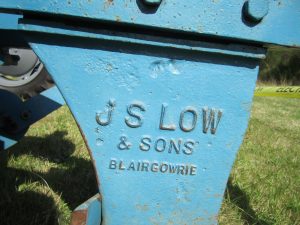 Rollers have become very common. Most of them are made of stone; others built with frames and loaded with stones; and a few of cast iron. These made of cast iron are more easily turned, because they generally consist of two cylinders, so constructed, that one moves backward, while the other moves forward, at the end of the ridge; which is convenient in rolling red land. With other rollers, which are composed of one piece of timber or stone, the best way is to go round the whole field in the form of a spiral line, where it can be done; and then to continue always going forward without making any short turns. In rolling down grass seeds with barley or oats, this method is preferable, but grass lands may be rolled any way; although rolling ridge and ridge is more tedious even in these; and therefore rolling across the ridges is preferable.
Rollers have become very common. Most of them are made of stone; others built with frames and loaded with stones; and a few of cast iron. These made of cast iron are more easily turned, because they generally consist of two cylinders, so constructed, that one moves backward, while the other moves forward, at the end of the ridge; which is convenient in rolling red land. With other rollers, which are composed of one piece of timber or stone, the best way is to go round the whole field in the form of a spiral line, where it can be done; and then to continue always going forward without making any short turns. In rolling down grass seeds with barley or oats, this method is preferable, but grass lands may be rolled any way; although rolling ridge and ridge is more tedious even in these; and therefore rolling across the ridges is preferable.
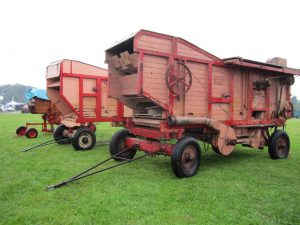 Thrashing of corn by machinery has been practised in this county for nearly half a century; and these machines are now coming fast into use. This construction is various, according to the ingenuity of the maker. They are driven sometimes by water, but in most cases by horses. They thrash more or less in proportion to the weight of water or the number of horses employed in driving them. Mr Paterson of Castlehuntly, who introduced them into the Catse of Cowrie, has one, which is very uncommon, both for the quantity and excellenec of its work. A farmer in Wester Lundie, near Doune, of the name of Ferguson, is said to gave invented a machine of this kind, very simple in its construction and very cheap; which are two considerations of importance to the common class of farmers. There are there erected already in the parish of Callander; and another about to be made soon. The three which have been made, cost each about L20. At the moderate calculation of one shilling per boll, either of these machines will repay their own expense by thrashing the first 400 bolls.
Thrashing of corn by machinery has been practised in this county for nearly half a century; and these machines are now coming fast into use. This construction is various, according to the ingenuity of the maker. They are driven sometimes by water, but in most cases by horses. They thrash more or less in proportion to the weight of water or the number of horses employed in driving them. Mr Paterson of Castlehuntly, who introduced them into the Catse of Cowrie, has one, which is very uncommon, both for the quantity and excellenec of its work. A farmer in Wester Lundie, near Doune, of the name of Ferguson, is said to gave invented a machine of this kind, very simple in its construction and very cheap; which are two considerations of importance to the common class of farmers. There are there erected already in the parish of Callander; and another about to be made soon. The three which have been made, cost each about L20. At the moderate calculation of one shilling per boll, either of these machines will repay their own expense by thrashing the first 400 bolls.
Fanners for cleaning grain have been long used by the most industrious of the farmers, and are to be met with, not only in every corn-mill, but almost in every barn, where the farm is more adapted for tillage than pasture.
Kilns for drying grain are sometimes made with time-ribs; which was the universal practice about half a century ago; many are made with brick-floors, but the cast-iron floors are daily gaining ground.
Churns, cheese presses and every other utensil of that nature are now made, in most places, after the most approved models.
Two horse carts have gone much into disuse; and are daily losing ground. Mr Mylne of Mylnefield, who had a great experience in this and every other article of rural economy, said that a cart of 22 cubic feet, in capacity, is as easily drawn by one horse, as one of 28 or 30 feet by two horses; this being the common size of carts in the Carse of Gowrie.
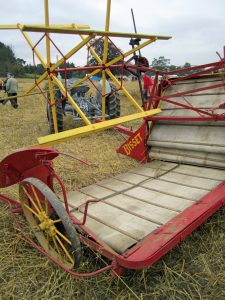 The expense of all implements of husbandry is so various in different districts of this extensive county, according to their quality and the neatness of their construction, that it would be difficult and even superfluous to give a detail of the different prices. Persons well skilled in making them have found it their interest to open shops almost in every village; which is an evidence of the good sense of the farmers, and that the obstinacy of prejudice is giving way to the growing taste for improvement.
The expense of all implements of husbandry is so various in different districts of this extensive county, according to their quality and the neatness of their construction, that it would be difficult and even superfluous to give a detail of the different prices. Persons well skilled in making them have found it their interest to open shops almost in every village; which is an evidence of the good sense of the farmers, and that the obstinacy of prejudice is giving way to the growing taste for improvement.
The average price of a cart properly constructed is from L8 to L9, and of ploughs with a chain and cast-iron mould board, from L2:2 to L3. The common cart may be from L1 11 6 to L2. The price of a threshing mill has been already mentioned, others are much dearer.
very few oxen are noe used for draught, except in the cases or clay land, and even in these districts, much fewer than formerly. The farmers allege, that in critical seasons the oxen are so slow, that they are under the necessity of preferring horses, for the sake of dispatch.
The photographs were taken at Scotland’s farming yesteryear, September 2014 and at other locations.
